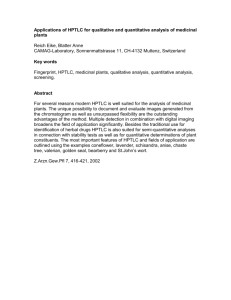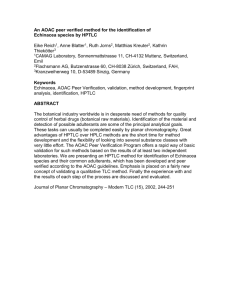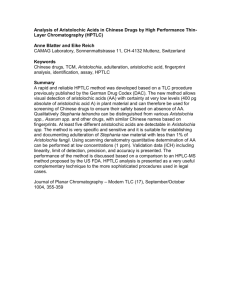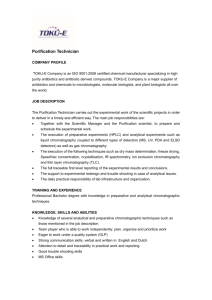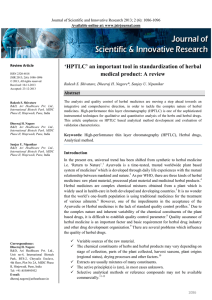Abstract
advertisement
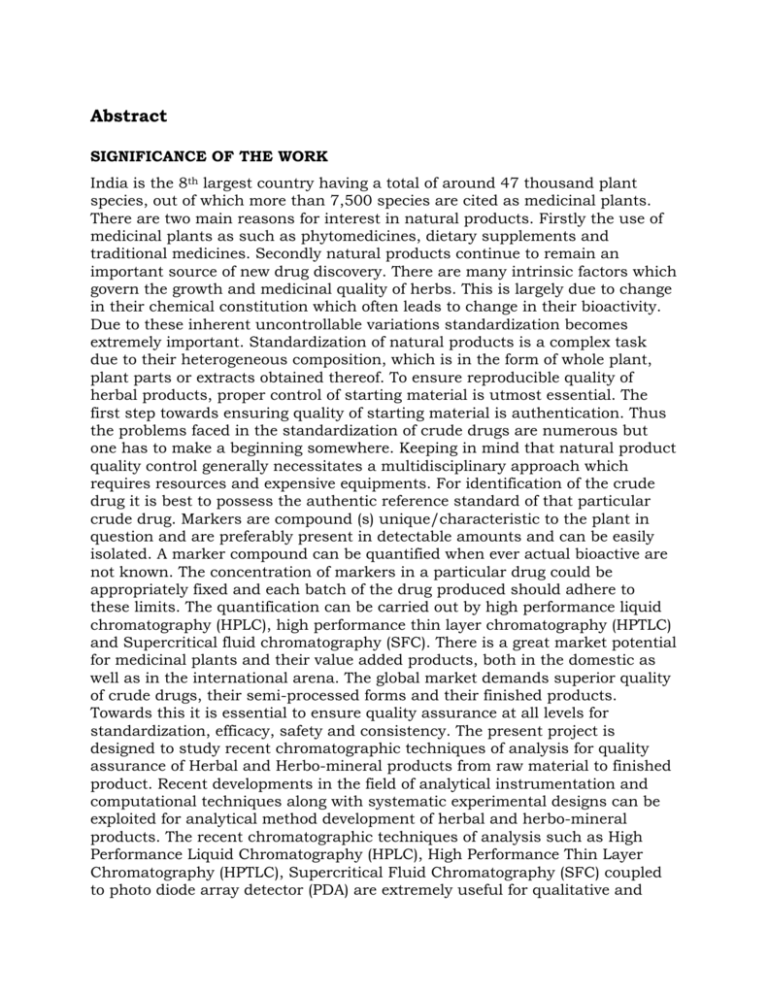
Abstract SIGNIFICANCE OF THE WORK India is the 8th largest country having a total of around 47 thousand plant species, out of which more than 7,500 species are cited as medicinal plants. There are two main reasons for interest in natural products. Firstly the use of medicinal plants as such as phytomedicines, dietary supplements and traditional medicines. Secondly natural products continue to remain an important source of new drug discovery. There are many intrinsic factors which govern the growth and medicinal quality of herbs. This is largely due to change in their chemical constitution which often leads to change in their bioactivity. Due to these inherent uncontrollable variations standardization becomes extremely important. Standardization of natural products is a complex task due to their heterogeneous composition, which is in the form of whole plant, plant parts or extracts obtained thereof. To ensure reproducible quality of herbal products, proper control of starting material is utmost essential. The first step towards ensuring quality of starting material is authentication. Thus the problems faced in the standardization of crude drugs are numerous but one has to make a beginning somewhere. Keeping in mind that natural product quality control generally necessitates a multidisciplinary approach which requires resources and expensive equipments. For identification of the crude drug it is best to possess the authentic reference standard of that particular crude drug. Markers are compound (s) unique/characteristic to the plant in question and are preferably present in detectable amounts and can be easily isolated. A marker compound can be quantified when ever actual bioactive are not known. The concentration of markers in a particular drug could be appropriately fixed and each batch of the drug produced should adhere to these limits. The quantification can be carried out by high performance liquid chromatography (HPLC), high performance thin layer chromatography (HPTLC) and Supercritical fluid chromatography (SFC). There is a great market potential for medicinal plants and their value added products, both in the domestic as well as in the international arena. The global market demands superior quality of crude drugs, their semi-processed forms and their finished products. Towards this it is essential to ensure quality assurance at all levels for standardization, efficacy, safety and consistency. The present project is designed to study recent chromatographic techniques of analysis for quality assurance of Herbal and Herbo-mineral products from raw material to finished product. Recent developments in the field of analytical instrumentation and computational techniques along with systematic experimental designs can be exploited for analytical method development of herbal and herbo-mineral products. The recent chromatographic techniques of analysis such as High Performance Liquid Chromatography (HPLC), High Performance Thin Layer Chromatography (HPTLC), Supercritical Fluid Chromatography (SFC) coupled to photo diode array detector (PDA) are extremely useful for qualitative and quantitative evaluation of herbal and herbo-mineral drugs. Gas chromatography (GC) however is not suitable for herbal analysis as only substances that can be volatilized at higher temperatures and which are thermolabile can be analyzed. HPLC is slow, cannot produce visual images but is useful for quantification. HPTLC is well suited to obtain a detailed fingerprint of herbal extract or product. Such a fingerprint comprises of scanning, in UV, fluorescence, UV spectra and photographic images in UV light (254 and 366 nm) and occasionally in visible light after derivatisation. HPTLC fingerprint is obtained at low cost and high speed and thus meets the need of a modern quality control method. HPTLC fingerprint serves a highly useful purpose in evaluating the changes in chemical composition during storage. The changes in HPTLC fingerprint pattern don’t necessary reflect appreciable change in bioactivity. Another approach of monitoring HPTLC fingerprinting includes assays of markers and generates data by determining the extent of bioactivity as a means of stability testing. Packed column SFC coupled to PDA detector is a promising novel chromatographic technique which can be employed for standardization of herbals having components with different λ values. Especially for herbals containing short wavelength components, the UV signal has to be recorded at low wavelengths (215 nm, e59200) in order to maximize sensitivity, requiring the use of solvent systems that are UVtransparent in this range. In LC methods, most solvents absorb strongly at the short wavelength required for sensitive detection. Excellent transparency of supercritical carbon dioxide at short UV wavelengths compelled us to investigate the analysis of these compounds by PC-SFC-DAD method. Among the published methods there are no integrated experimental design based fingerprint development studies, which include development, optimization and validation of the method. In this work we describe a strategy for method development, optimization and validation of HPTLC and PC-SFC-DAD methods for fingerprint development studies of herbal extract as well as commercial formulations. Some controllable parameters and the range of the factors, which need to be optimized, were selected. Optimization was performed using a uniform design, which is very useful when a large number of levels are evaluated. The use of this approach in the context of herbal analysis problem where the components have more or less similar chemical structure and their separation remains still a challenging task for the pharmaceutical analyst. It is therefore necessary to establish universal and systemized approach to conveniently develop reliable chromatographic fingerprints of herbal medicines. The last step was method validation as per the recommendations laid down by ICH guidelines [52-54] consisting of injection precision, repeatability, reproducibility and sample stability test. The present study is also an effort to evaluate temperature dependence of the enantioselectivities for dextro and levo- herbal optical isomers under PC-SFC-DAD conditions from a thermodynamic point of view A sensitive, selective, precise and robust high-performance thin-layer chromatographic method of analysis of E and Z stereoisomers of guggulsterone (the hypolipidemic agent in the gum-resin exudates of Commiphora mukul) both as a bulk drug and in formulations was developed and validated. The method employed TLC aluminium plates precoated with silica gel 60F-254 as the stationary phase. The solvent system consisted of toluene- acetone (9:1, v/v). Densitometric analysis of guggulsterone was carried out in the absorbance mode at 250 nm. This system was found to give compact spots for E- and Z- guggulsterone, (Rf value of 0.38 ± 0.02 and 0.46 ± 0.02 respectively) following double development of chromatoplates with the same mobile phase. The linear regression analysis data for the calibration plots for E- and Z- guggulsterone showed good linear relationship with r2 = 0.9977 ± 0.054 and r2 = 0.9975 ± 0.068 respectively in the concentration range of 100 ng/spot to 6000 ng/spot. The mean value of slope and intercept were 0.11 ± 0.006 and 0.11 ± 0.005, 14.26 ± 0.56 and 10.92 ± 0.76 respectively for E- and Z- guggulsterone. The method was validated for precision, robustness and recovery. The limit of detection and quantitation were 12 ng/spot, 10 ng/spot and 24 ng/spot, 20 ng/spot respectively for E- and Z- guggulsterone. Statistical analysis proves that the method is repeatable and selective for the estimation of the said drug. Since the proposed mobile phase effectively resolves the E- and Z- isomers of guggulsterone, this HPTLC method can be applied for identification and quantitation of these isomers in herbal extracts and pharmaceutical dosage form. Key words: Guggulsterone; E and Z stereo isomers; Commiphora mukul; HPTLC Stress degradation studies were carried out on guggulsterone (the hypolipidemic agent in the gum-resin exudates of Commiphora mukul) following the conditions prescribed in the parent drug stability testing guideline (Q1AR) issued by International Conference on Harmonization (ICH). The present study describes degradation of guggulsterone under different ICH prescribed stress conditions (acid and base hydrolysis, oxidation, dry and wet heat degradation and photodegradation) and establishment of a stability indicating HPTLC assay. The method employed TLC aluminium plates precoated with silica gel 60F-254 as the stationary phase. The solvent system consisted of toluene- acetone (9:1, v/v). Densitometric analysis of guggulsterone was carried out in the absorbance mode at 250 nm. This system was found to give compact spots for E- and Zguggulsterone, (Rf value of 0.38 ± 0.02 and 0.46 ± 0.02 respectively) following double development of chromatoplates with the same mobile phase. The drug undergoes degradation under acidic and basic conditions, oxidation, dry and wet heat treatment and photodegradation. All the peaks of degraded products were resolved from the standard guggulsterone with significantly different Rf values. As the method could effectively separate the drug from its degradation products, it can be employed as a stability indicating one. Key words: Guggulsterone; Commiphora mukul; HPTLC; Stability indicating; Stress degradation. Two chromatographic techniques are described for the separation and quantitative determination of azadirachtin A and B, salannin, and nimbin present in the crude extract of neem seed kernels and commercial neem based formulations. The high performance thin-layer chromatography (HPTLC) separation of markers was carried out on Merck TLC aluminium sheets of silica gel 60 F254 using ethylacetate-benzene (7.0: 3.0, v/v) as mobile phase. The other technique was based on extended length packed column supercritical fluid chromatographic (PC-SFC) separation of the markers using Cyano column (250 mm × 4.6 mm I.D, S-5.0 µ) and Kromasil 100 NH2 column (250 mm × 4.6 mm I.D, 5.0 µ) connected in series. The detection was carried out using photodiode array detector at 338 K using methanol-modified carbon dioxide (10 %) as the mobile phase at flow rate of 2.0 mL min-1. The current study assesses the effect of extending column length during PC-SFC experiment to obtain maximum resolution between a number of unknown components and known markers present in neem seed extracts. Both the chromatographic methods were validated in terms of precision, robustness, recovery, limits of detection and quantitation. The analysis of variance (ANOVA) and Student’s t-test were applied to correlate the results of quantitative determination of markers by means of HPTLC and PC-SFC method. Key words: Thin layer chromatography; Supercritical fluid chromatography; Method validation; Azadirachtin A and B, salannin and nimbin.
